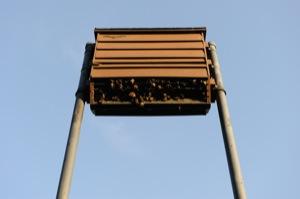 One of the things that I love about living in the mountains and a rural area is my connection with nature, which includes seeing wildlife on a regular basis. We have seen foxes, bobcats, elk, moose, and other wild animals in our neighborhood. But a couple of years now, we discovered one particular animal had taken up residence inside our residence — bats. I detailed the story of finding a little brown bat hanging on a beam above our bed in a blog post from last year. We had hoped and thought that was an isolated occurrence. But last year as Bryon was doing work outside the house and was standing on the ladder working on the eaves, he saw little faces and beady eyes staring back at him. Turns out an entire colony of bats had made a home for themselves under the eaves of the southeastern corner of our house. It made us a little nervous that they might find a way back in again, and much as I love wildlife, I didn’t want bats flying, pooping or otherwise living inside the house again. What to do?
One of the things that I love about living in the mountains and a rural area is my connection with nature, which includes seeing wildlife on a regular basis. We have seen foxes, bobcats, elk, moose, and other wild animals in our neighborhood. But a couple of years now, we discovered one particular animal had taken up residence inside our residence — bats. I detailed the story of finding a little brown bat hanging on a beam above our bed in a blog post from last year. We had hoped and thought that was an isolated occurrence. But last year as Bryon was doing work outside the house and was standing on the ladder working on the eaves, he saw little faces and beady eyes staring back at him. Turns out an entire colony of bats had made a home for themselves under the eaves of the southeastern corner of our house. It made us a little nervous that they might find a way back in again, and much as I love wildlife, I didn’t want bats flying, pooping or otherwise living inside the house again. What to do?
I consulted with my fellow Park Ranger, Marilyn, who happens to be an expert on bats. Marilyn has been doing a Junior Ranger program for years that is all about bats. Ranger Marilyn suggested providing an alternate home for the bats so they wouldn’t make their home in our home — a bat house! Turns out there is lots of information on bat houses through an organization called OBC, Organization for Bat Conservation. They even sell bat houses. Turns out bats are pretty particular about what they like, which is a consideration when purchasing or building a bat house. They prefer houses constructed of cedar with lots of room. Bats also seem to prefer southeastern exposure, something that isn’t too warm. I’m sure it’s no coincidence that the eaves the bats are hanging out under are on the southeast corner of the house. Marilyn suggested if we really want the bats to use the bat house, we should ideally mount it directly on the siding of our house. Apparently, success with a bat house can be a double-edged sword — it’s great they are using it instead of our own house, but once they establish themselves, they can produce quite a family — up to 80 or more bats in a bat house.
I’m sure some people think it’s crazy to encourage the bats to come back to our house, but the truth is, they do lots of wonderful things for the ecosystem that we greatly appreciate. First and foremost, they can consume thousands of bugs weekly, and since bugs are also trying to get into our house, anything that can reduce the number is welcome. Plus, as the only truly flying mammal using echolocation to navigate, they are pretty amazing animals to watch.
We are in the process now of deciding whether to build our own bat house, or purchase one already made. One thing is for sure, we need to do something and quickly. With winter coming to a close, the bats will be returning soon to our Nederland home — hopefully they will find a welcoming environment in their new house.

